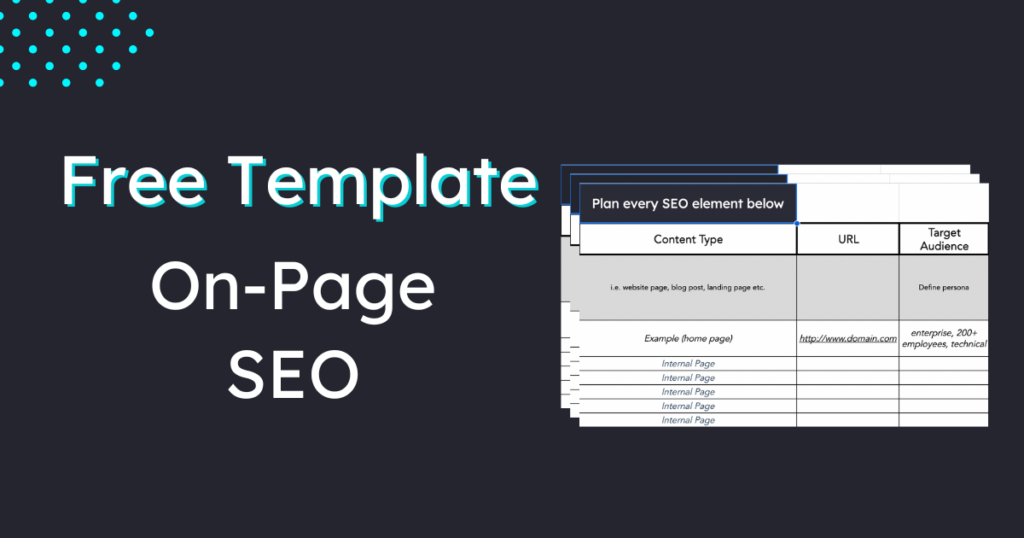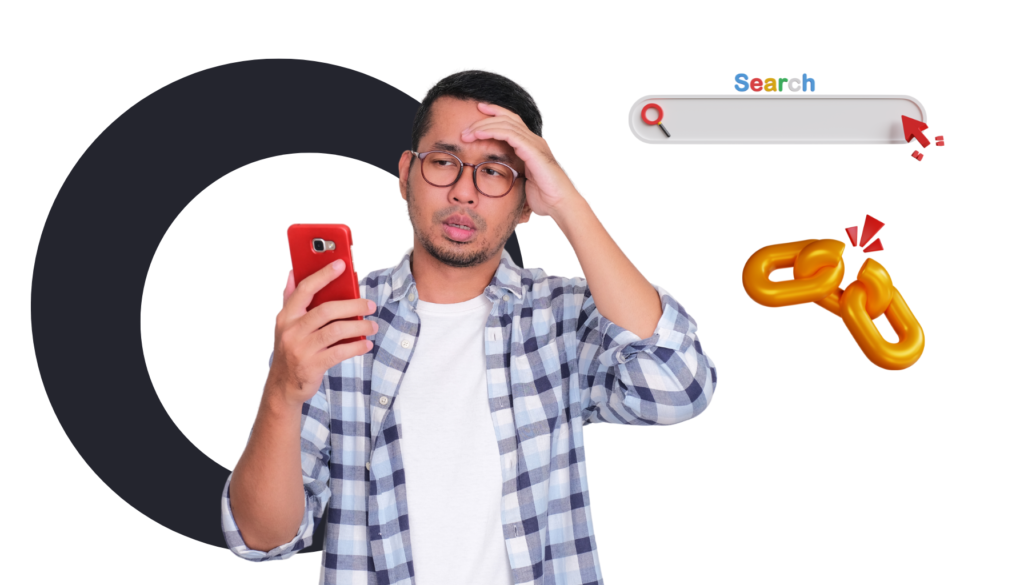
Did you know around 58% of Google searches now result in zero clicks? That means more than half of all search queries end without users visiting a single website.
For businesses that rely on search engines to drive high-intent traffic to their sites, this is a major shift—and not necessarily a welcome one.
By answering users’ questions directly on the search engine results page (SERP), Google leaves many websites scrambling to adapt as organic traffic and search-driven conversions decline.
However, while zero-click searches might be dominating the SERPs, businesses that adapt can still make it through in this new era of search.
Here you’ll see how you can optimize your strategy to stay competitive, maintain visibility, and mitigate the impact on your conversions. Let’s dive in!
Table of Contents
What Are Zero-Click Searches?
A zero-click search is exactly what it sounds like: a search query that ends without the user clicking through to a website. Instead, the search engine itself provides the answer directly on the results page. Formats can include:
- Featured snippets: Those boxed answers at the top of the page, pulling information from a website to address a query concisely.
- Knowledge panels: The detailed information blocks on the right-hand side of the SERP, often used for brands, people, or organizations.
- Local packs: Maps and business listings that appear for location-based searches like “restaurants near me.”
- Rich results: Search enhancements like recipe instructions, event details, or FAQs.
These features deliver immediate, on-point answers, making it easier for users to find what they need without leaving Google’s ecosystem. While it’s great for user convenience, the downside is clear: fewer clicks mean less traffic heading to your site.
Why is this happening? Google’s goal is to keep users on its platform for as long as possible, offering everything from definitions to product recommendations right on the SERP. As a result, zero-click searches have become a key part of its strategy—and they’re only getting more prevalent.
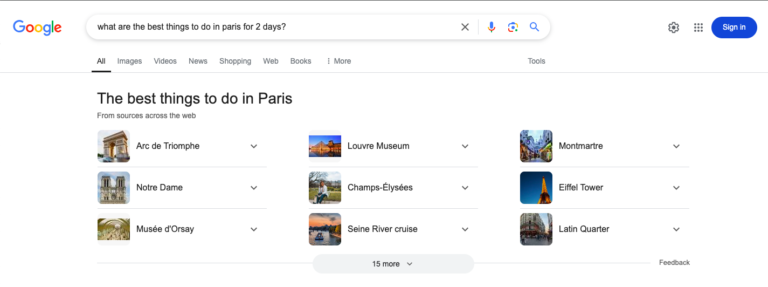
Take this example above: if you searched “things to do in Paris” before zero-click searches Google would probably show you a list of online travel guides, and you would click on one of them to see the list. Now, you can see Google presents you a list of things to do in Paris, sorted out from scrawling through different websites.
This means one less step for the user, one less visitor for the online travel guide, and more time spent directly on Google.
What Types of Queries Typically Result in Zero-Click Searches
Not all search queries lead to zero-click results, but certain types are far more likely to trigger them. Understanding these query types is the first step to optimizing your strategy and making the most of on-SERP opportunities.
Here are the main categories of queries that commonly result in zero-click searches:
1. Quick answers and definitions
These are the bread and butter of zero-click searches. Queries like “What is SaaS?” or “How many ounces in a cup?” are perfect for featured snippets or Google’s instant answers. These results are designed to give users concise, no-click-needed responses.
2. Calculations and conversions
Need to calculate a loan payment or convert 10 euros to dollars? Google’s built-in calculator and currency conversion tools provide answers without requiring users to leave the SERP.
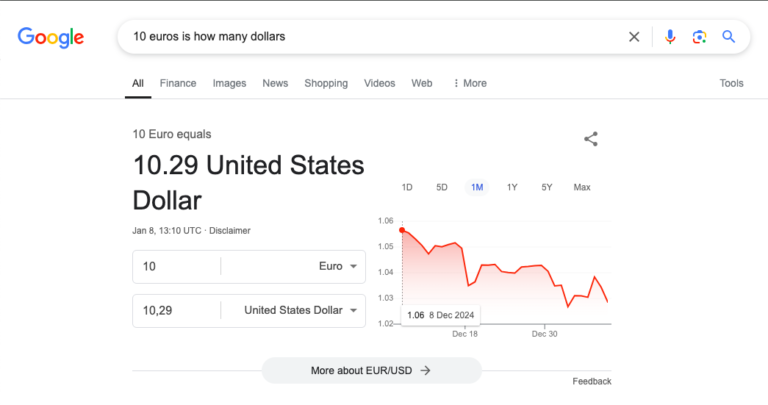
3. Local and “Near Me” searches
When people search for “Best pizza near me” or “Gas station open now,” Google’s local search results often dominate the page. These include maps, ratings, reviews, and even call-to-action buttons like “Call” or “Directions.”
4. FAQs and how-to questions
Informational queries like “How to change a watch battery” or “What is zero-click search?” often pull content from detailed articles into featured snippets, videos, or step-by-step guides. Users can often get the answer they need directly from the SERP.
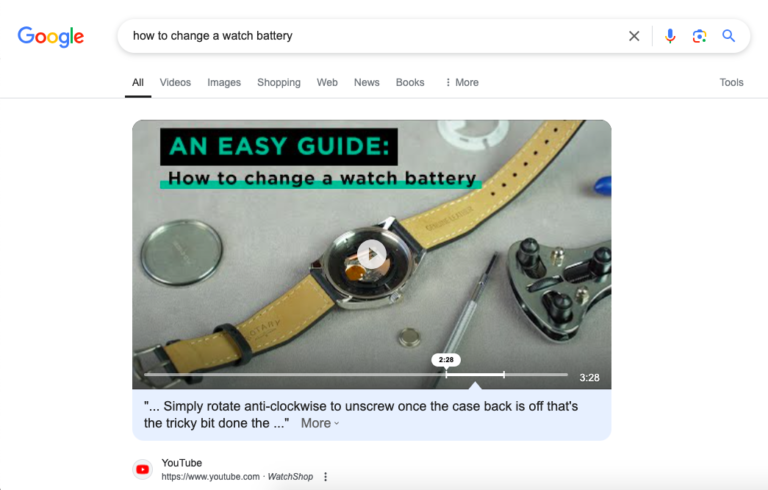
5. Branded and entity searches
When users search for well-known brands, public figures, or organizations, knowledge panels often appear, showcasing curated information like history, founders, and even social media links.
6. Event and date-driven queries
Questions like “When is Black Friday?” or “What time is the Super Bowl?” are almost guaranteed to show rich results or featured snippets. Google uses structured data to provide instant, accurate answers.
By identifying which of your target audience’s queries are likely to result in zero-click results, you can start tailoring your content and visibility strategies to align with these formats. The goal is to ensure that when users encounter your brand in a zero-click result, it’s a positive, trust-building interaction—even if they don’t click through.
Now let’s see how you can make the most of zero-click searches.
How To Optimize for Zero-Click Searches?
In this section you will learn what to do to enhance on-SERP visibility. Next on we’ll see how to ease the impact of zero-click searches on your conversions.
It’s a simple assumption: if users aren’t clicking through, the focus shifts from only driving traffic to dominating the SERP real estate and strengthening your brand’s visibility:
1. Optimize for featured snippets
Featured snippets are the crown jewels of SERP visibility, offering businesses the chance to appear at the very top of search results. Here’s how to increase your chances of landing a featured snippet:
- Structure content clearly: Organize your content into easily digestible formats like headers, bullet points, tables, or numbered lists. For example, if you’re explaining the benefits of SaaS solutions, use a numbered list to break down key points.
- Answer questions directly: Start with a concise, straightforward answer (40–60 words) to the user’s query before diving into the details. For example, a blog post on “What is cloud computing?” could start with, “Cloud computing is the delivery of computing services—such as storage, databases, and software—over the internet to provide faster innovation and flexibility.”
- Focus on question-based keywords: Optimize your content for questions users are searching for, incorporating terms like “What is,” “How to,” or “Why does.” For example, if you run a marketing agency, you might target queries like “How to create a social media strategy” or “What is content marketing?”
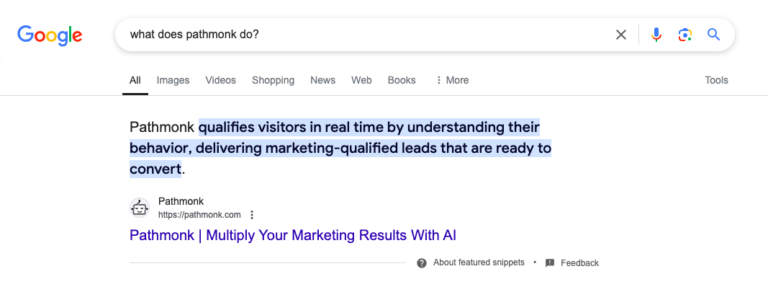
2. Leverage local SEO for “Near Me” queries
Local searches are one of the most common types of zero-click results, thanks to Google’s local packs and Maps integrations. When users search for phrases like “lawyers near me” or “best coffee shop in Brooklyn,” they’re often greeted with a list of businesses, reviews, and actionable options like “Call” or “Get Directions.”
To stand out in these results and attract local customers, here’s what you can do:
- Claim and optimize your Google My Business profile: Ensuring it’s complete and accurate not only improves your chances of appearing in the local pack but also builds trust with potential customers.
- Encourage reviews: Positive reviews are a powerful ranking factor for local packs and Maps results. They also act as social proof, encouraging users to choose your business over competitors.
- Use location-specific keywords: Incorporating location-specific keywords into your website content helps you rank for searches in your area. Incorporate phrases like “SaaS solutions in Chicago” to align with local searches.
3. Implement schema markup
Schema markup is a behind-the-scenes tool that helps search engines understand your website content and present it in visually appealing, informative rich results. By implementing schema, you can increase your chances of appearing in highly clickable SERP features. Here’s how you can leverage schema markup effectively:
- FAQ schema allows search engines to display frequently asked questions from your content directly on the SERP.
- For businesses hosting events, schema markup ensures that details like dates, locations, and times appear directly on the SERP.
- Product schema can showcase detailed information such as pricing, availability, and customer reviews directly on the SERP, helping eCommerce businesses stand out.
- News and blog posts can benefit from schema markup to appear in “Top Stories” carousels or other rich snippets designed for timely, relevant content.
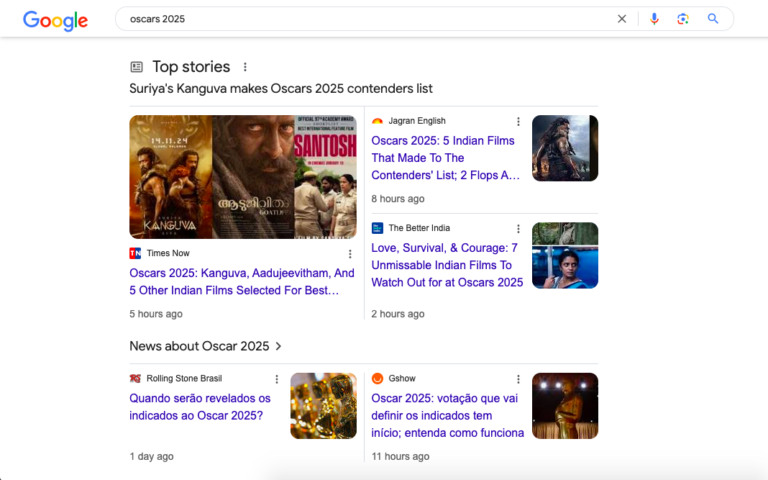
4. Create FAQ-style content
Zero-click searches often center around answering common questions, making FAQ-style content a powerful tool for boosting your on-SERP visibility. Here’s how to do it:
- Research FAQs in your niche: Start by identifying the questions your target audience is asking. Use tools like AnswerThePublic or Google’s “People Also Ask” box.
- Write short, direct answers: Begin each FAQ answer with a concise, easy-to-digest response (40–60 words), followed by a detailed explanation for users who want to learn more.
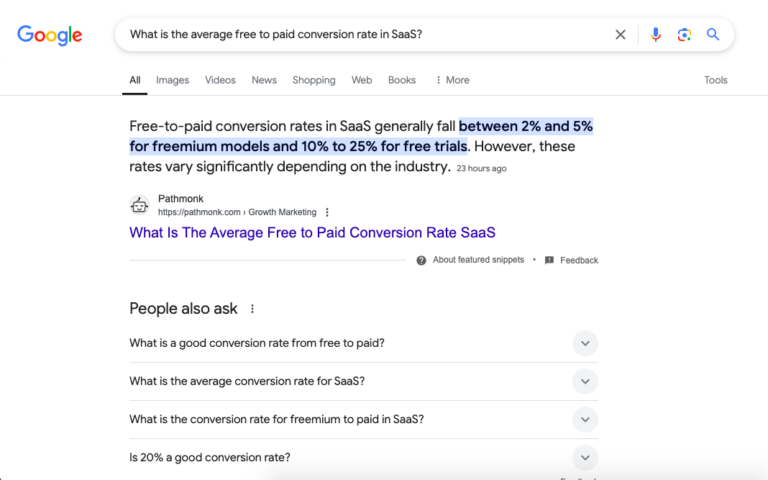
Pro Tip: Embed internal links within FAQ answers to guide users who do decide to click.
5. Strengthen your brand presence in knowledge panels
Knowledge panels are one of the most visible and authoritative elements on the SERP, often appearing for branded and entity-based searches on the right corner.
- Claim your entity: To establish your brand’s presence in a knowledge panel, you need to verify your business or organization with Google.
- Ensure consistent branding: Use the same logos, descriptions, and contact information across platforms. Google pulls data from multiple sources to create knowledge panels, so consistency is key.
- Leverage Wikidata and Wikipedia: Knowledge panels often draw from trusted public sources like Wikidata and Wikipedia. Contributing to these platforms can help solidify your brand’s presence.
Future-Proof Strategy to Mitigate the Impact of Zero-Click Searches on Conversions?
The rise of zero-click searches presents a unique challenge: how can businesses convert organic traffic when users obtain information directly from search results? The key lies in maximizing the potential of the visitors who do reach your site. This is where Pathmonk comes into play.
Pathmonk is an AI-powered conversion optimization tool designed to enhance the effectiveness of your existing organic traffic. Pathmonk can help mitigate the impact of zero-click searches on your conversions by understanding your visitor’s intent and showing your visitors exactly what they’re looking for
Pathmonk customizes each visitor’s experience by aligning their search intent with a tailored website experience, significantly boosting your chances of conversion. It’s like offering every visitor a uniquely personalized landing page, fully optimized for conversions—all without any manual effort.

As a result, you get:
Instead of focusing solely on driving more visitors to your site, Pathmonk emphasizes on generating more leads the traffic you already have. By analyzing visitor behavior in real-time, Pathmonk delivers personalized experiences that guide users toward conversion. This approach leads to a significant boost in your conversion rate—clients have reported an average of 50% increase, with a minimum guarantee of 20% growth within the first 30 days, or your money back!
2. Improved sales with highly-qualified leads:
Our advanced data engine uncovers valuable information about the companies visiting your site, giving your sales team the insights needed to target organizations that have already shown interest in your product, increasing your chances of closing deals.
3. A better understanding of your customer analytics:
Our AI analyzes and predicts your prospects’ behavior, helping you master the complete customer journey and uncover growth opportunities, making data-driven decisions that have a real impact on your revenue.
Increase +180%
leads
demos
sales
bookings
from your website with AI
Get more conversions from your existing website traffic delivering personalized experiences.

By focusing on converting existing traffic through personalized, intent-driven experiences, you not only preserve but enhance your conversion rates, turning potential obstacles into opportunities for growth.


